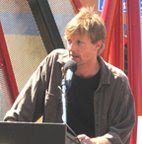Typically, "faux finish" describes the process of making a surface look like something it really isn't using paint, stain and the like. There are several examples of this in the painted finishessection of my portfolio site www.john-scenic.com, but the most recent and convenient example is in my last post about the Olivenhain project I did with Chism Brothers.
One of the finishes for that project was done on the baseboards and mouldings surrounding the windows and doors in the family room. Using a five step process, I painted these paint-grade white mouldings to look like the honey colored wood used on the fireplace mantel and crown mouldings.

In this picture, the crown moulding at the ceiling is real wood with a honey colored stain. The mouldings around the windows were originally painted white, and I painted them to look like the same wood as the crown. This is a "faux finish": the mouldings are real, but they are painted to look like something (stained hardwood) they really are not.
"Trompe l'oeil" is a French expression that translates as "to fool the eye", and while a faux finish like the one above fools the eye, "trompe l'oeil" is typically reserved for painting that convinces the viewer that something is there that really is not there, like a window or doorway drawn in accurate perspective so that it seems three dimensional. The accuracy of the drawing and the faithfulness of the painting to how the subject matter would look in reality is critical to being "trompe l'oeil" rather than merely decorative painting.
Here is an example of architectural trompe l'oeil from the custom murals section of my site.

The window is "built" like the real windows in the rest of the room, i.e., with the same proportions, same mouldings, etc. but it is drawn and painted on a wall that has no real window. The "view" mimics the real trees, fence, etc. that are outside the house and that you would see if the window was real. And it is drawn in a mechanically accurate perspective, so that it appears to the eye three dimensionally just as it would if it were really there.
Getting back to the Point Loma project then, I use both terms to describe that finish because I used both techniques to create the stone blocks on a blank wall.

Each block was measured and taped off and made to look like stone with paint, i.e., "faux painted". Then highlight and shadows were painted to correlate to how the blocks would look in the light of the room (both natural (daytime) & artificial (at night)) if they were three dimensional, in this case, with a 1/4" bevel on all four sides of each block. This is the "trompe l'oeil" component: look again at the picture and remember that the light fixture is mounted to a wall that is completely flat in reality. The stone blocks you see are rendered entirely in paint, both the stone texture (faux) and the three dimensional block (trompe l'oeil).



No comments:
Post a Comment